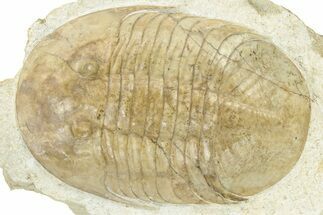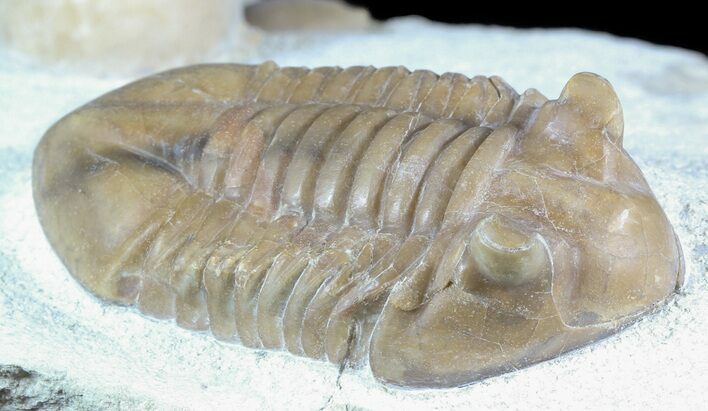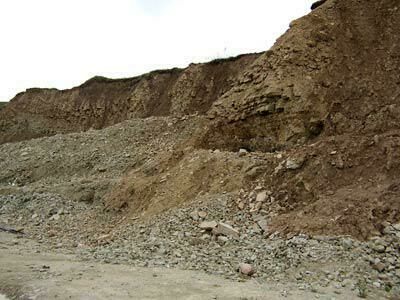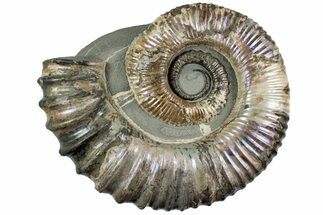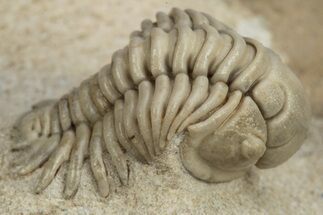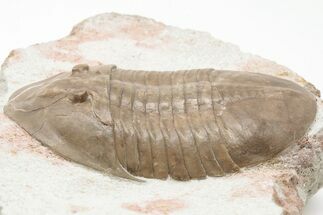This Specimen has been sold.
2" Asaphus Kotlukovi Trilobite With Cystoid
This is an 2" long specimen of the trilobite Asaphus kotlukovi from the Vilpovitsy quarry near St. Petersburg, Russia. It's Middle Ordovician in age or approximately 465 million years old. The trilobite is extremely 3D, preserved prone, and has beautiful shell preservation. The preparation to remove the limestone that was surrounding this specimen was very well done, preserving amazing shell detail. There is also a cystoid and another partial trilobite present on the limestone.
Like nearly all of these Asaphus trilobites there is some shell restoration, about 8-10% along repaired cracks through the trilobite. The cystoid maybe composited onto the matrix, but it's hard to tell for sure.
Like nearly all of these Asaphus trilobites there is some shell restoration, about 8-10% along repaired cracks through the trilobite. The cystoid maybe composited onto the matrix, but it's hard to tell for sure.
Cystoids are extinct echinoderms similar to crinoids. They consist of a stalk, theca (body), and brachials (feeding arms). Most lived fixed to the seafloor, but some were more mobile. Like modern echinoderms, cystoids were arranged in a fivefold symmetric pattern and had a water vascular system. However, unlike most echinoderms, cystoids had triangular calcite plates at their body openings containing pores that are thought to have been for breathing.
Cystoids first appear in the Cambrian Period and reached peak diversity during the Ordivician and Silurian Periods. Cystoids died out at the end of the Devonian or early in the Carboniferous Period.
Cystoids resembled flowers, but were in fact animals. They had a stem that attached them to the seafloor, a theca, and brachials. The theca contained the cystoid's vital organs and was made up of calcite plates that formed a spherical or ovate body. The brachials were the feeding arms that extended from the top of the theca, arranged in three- or five-fold symmetry, and funneled food to the mouth at their center. Cystoids and crinoids look similar but have some distinct differences. The main difference is in the shape of the main body of the organisms: cystoids had a spherical or ovate theca, while crinoids had a cup shaped calyx. Cystoids also had triangular plates at body openings while crinoids had variably shaped plates.
Cystoids first appear in the Cambrian Period and reached peak diversity during the Ordivician and Silurian Periods. Cystoids died out at the end of the Devonian or early in the Carboniferous Period.
Cystoids resembled flowers, but were in fact animals. They had a stem that attached them to the seafloor, a theca, and brachials. The theca contained the cystoid's vital organs and was made up of calcite plates that formed a spherical or ovate body. The brachials were the feeding arms that extended from the top of the theca, arranged in three- or five-fold symmetry, and funneled food to the mouth at their center. Cystoids and crinoids look similar but have some distinct differences. The main difference is in the shape of the main body of the organisms: cystoids had a spherical or ovate theca, while crinoids had a cup shaped calyx. Cystoids also had triangular plates at body openings while crinoids had variably shaped plates.
SPECIES
Asaphus kotlukovi
LOCATION
Vilpovitsy quarry, St. Petersburg region, Russia
FORMATION
Asery level
SIZE
Trilobite 2" long, matrix 5.6x3.1"
CATEGORY
SUB CATEGORY
ITEM
#45985
We guarantee the authenticity of all of our specimens.
 Reviews
Reviews



